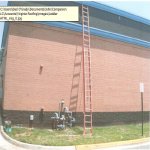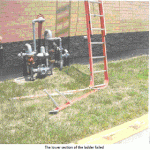kenaslan
Senior Member
- Location
- Billings MT
Photos and incident description provided by Virginia Roofing, Inc.
Significant Near Miss Involving a Fiberglass Extension LadderLadder Inspections - Why they are so Important
Two roofing technicians were going on to a flat roof to perform an inspection and repair. The first technician set up a 30 foot extension ladder to access the roof. The ladder was a Type IA Fiberglass ladder rated for a load capacity of 300 pounds. The technician weighed approximately 160 pounds. The ladder had been inspected and was less than 2 months old. The ladder had not been damaged or subjected to any harsh conditions.
As the technician was climbing the ladder he felt the ladder start to give from underneath him. He was able to reach and hold on to the roof edge as the ladder collapsed. The second technician was able to get another ladder from their service truck, set the ladder up and get the first technician down safely without incident.

Ladder collapsed ? worker was able to grab on to the leading edge of the building

The lower section of the ladder failed
InvestigationAll fiberglass ladders were immediately brought in from the field and closely examined for any possible defects or damage. The company found that on approximately 20% of their fiberglass extension ladders there were very small cracks in the fiberglass on the siderails immediately next to the rungs of some ladders.
Very small cracks in the siderail fiberglass adjacent to the rungs
Small cracks in the fiberglass adjacent to the ladder rung
In addition to the small cracks in the fiberglass in some areas the fiberglass material had split.
Follow-upThe small cracks found in the siderails of the extension ladders were not noted to be in any pattern along the siderail. The cracks and splits in the fiberglass were found to be immediately next to the rungs on the outside portion of the siderail.
Currently it is believed the fiberglass may have been damaged or fatigued during the manufacturing process when the rungs were crimped into the siderail of the ladder.
RecommendationsThe small cracks around the rungs are not easily detected by a quick visual inspection. Workers need to ?feel? with their finger tips for any raised spots in the fiberglass and remove any debris along the side rails in the areas where the rungs are crimped to check for small cracks or splits.
The cracks were not found in any pattern or specific location on all the ladders inspected. It is important to inspect each rung on both the exterior and interior side of the siderail for any signs of cracks or splits in the fiberglass.
Any fiberglass ladder with these small cracks should be removed from service.
Significant Near Miss Involving a Fiberglass Extension LadderLadder Inspections - Why they are so Important
Two roofing technicians were going on to a flat roof to perform an inspection and repair. The first technician set up a 30 foot extension ladder to access the roof. The ladder was a Type IA Fiberglass ladder rated for a load capacity of 300 pounds. The technician weighed approximately 160 pounds. The ladder had been inspected and was less than 2 months old. The ladder had not been damaged or subjected to any harsh conditions.
As the technician was climbing the ladder he felt the ladder start to give from underneath him. He was able to reach and hold on to the roof edge as the ladder collapsed. The second technician was able to get another ladder from their service truck, set the ladder up and get the first technician down safely without incident.

Ladder collapsed ? worker was able to grab on to the leading edge of the building

The lower section of the ladder failed
InvestigationAll fiberglass ladders were immediately brought in from the field and closely examined for any possible defects or damage. The company found that on approximately 20% of their fiberglass extension ladders there were very small cracks in the fiberglass on the siderails immediately next to the rungs of some ladders.
Very small cracks in the siderail fiberglass adjacent to the rungs
Small cracks in the fiberglass adjacent to the ladder rung
In addition to the small cracks in the fiberglass in some areas the fiberglass material had split.
Follow-upThe small cracks found in the siderails of the extension ladders were not noted to be in any pattern along the siderail. The cracks and splits in the fiberglass were found to be immediately next to the rungs on the outside portion of the siderail.
Currently it is believed the fiberglass may have been damaged or fatigued during the manufacturing process when the rungs were crimped into the siderail of the ladder.
RecommendationsThe small cracks around the rungs are not easily detected by a quick visual inspection. Workers need to ?feel? with their finger tips for any raised spots in the fiberglass and remove any debris along the side rails in the areas where the rungs are crimped to check for small cracks or splits.
The cracks were not found in any pattern or specific location on all the ladders inspected. It is important to inspect each rung on both the exterior and interior side of the siderail for any signs of cracks or splits in the fiberglass.
Any fiberglass ladder with these small cracks should be removed from service.
